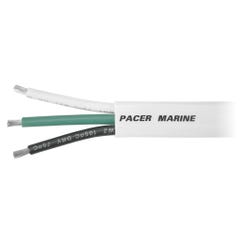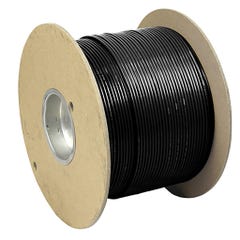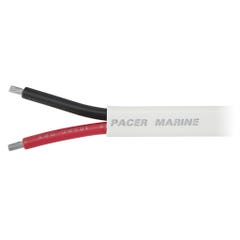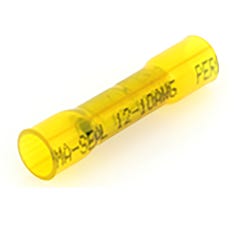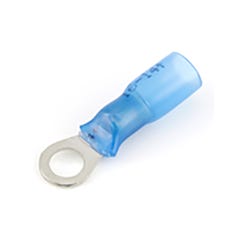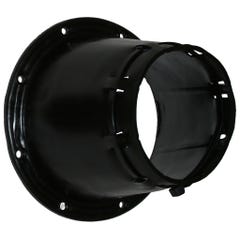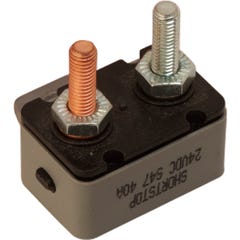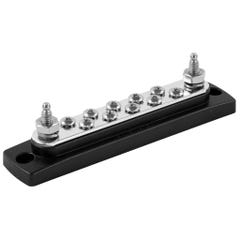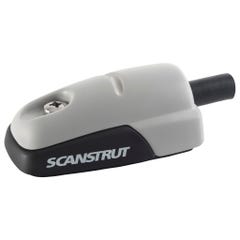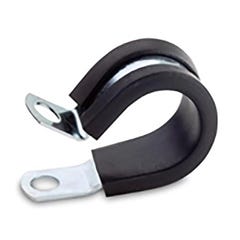Choosing the Right Size Boat Wire
May 04, 2023 8 min read


Wiring a boat can be a daunting task. Even the simplest skiffs seem to have miles of wires that all run in different directions and only converge into the console to create a rat’s nest of confusion. However, boat yards can be backed up for months, and with shop labor rates upwards of $100 an hour, doing it yourself can get your boat in the water quickly and save you money. Whether you’re fixing old faulty wiring, reorganizing a switch panel or running a new accessory, it’s important to know a few basics. One of these basics is what gauge wire to use.
Contents
- 1. Smaller Number, Bigger Wire
- 2. Factors to Consider
- 2.1 Are You Wiring Something Critical or Non-Critical?
- 2.2 How Far Do your Wires Need to Run?
- 2.3 What Amount of Current Does your Equipment Require?
- 2.4 Will your Wiring Run Through an Enclosed Engine Compartment?
- 2.5 Are you Bundling your Wires?
- 3. Wire Size Charts
- 3.1 Let’s look at an example:
- 3.2 Here’s another example:
- 4. Too Big Is Better than Not Big Enough
- 5. Typical Boat Wire Sizes
- 6. AWG vs SAE Wire
Smaller Number, Bigger Wire
Marine wiring comes in a variety of sizes, which are measured in gauge. Gauge is a measure of wire thickness. As a general rule, the smaller the gauge number, the thicker the cable. For example, 8 AWG (American Wire Gauge) cable is slightly over 3 millimeters thick, whereas 18 gauge wire is only 1 millimeter thick. This thickness is a measurement of the conductor itself, and does not take into consideration the coating around the wire.
Wire used on boats typically ranges from 18 gauge for LED lights and other low-amperage accessories to 2/0 for some battery cables. Like fishing hook sizes, wire size “reverse” once they go below zero. So, in order of increasing size, gauges are 4, 2, 1, 1/0, 2/0, 3/0 and so on.
Factors to Consider
There are a few things you need to know to figure out what size wire you need. Most of these factors are influenced by voltage drop, which is defined as the decrease of electric potential along the path of a current flowing in a circuit. In layman’s terms, it’s when the voltage is lower on the end of the cable than it was coming from the power source. It’s related directly to how long your wires have to run, and can be easily calculated and compensated for. Here are a few things you’ll need to know.
1. Are You Wiring Something Critical or Non-Critical?
The American Boat and Yacht Council (ABYC) has different voltage drop margins for critical equipment and non-critical equipment. For critical equipment, only 3 percent voltage drop is acceptable. On non-critical equipment, up to 10 percent is acceptable. Critical items would include bilge blowers, bilge pumps, navigation lights and communication equipment. Livewell pumps, stereos and courtesy lights are examples of non-critical equipment.
2. How Far Do your Wires Need to Run?
The longer your wires, the greater the voltage drop. One end of your wire might measure 12.8 volts, but further down the wire might only measure 9 volts. Over a given distance, voltage drops less in thicker wire than thinner wire. On small boats where wires only need to run short distances, this may not be a major consideration, but over long distances it is important to keep this in mind.
3. What Amount of Current Does your Equipment Require?
Electrical current is measured in amps, short for amperes. Amps are units of constant electrical current, not to be confused with voltage. The more current your piece of electrical equipment needs, the bigger the wire required to carry it. Some equipment will supply this number. For example, a Rule 1500 GPH bilge pump has a max current draw of 4.8 amps.
4. Will your Wiring Run Through an Enclosed Engine Compartment?
Heat increases resistance in wires, reducing their ability to carry current. In other words, the higher the temperature, the greater the voltage drop and the bigger the wire required. Most wire manufacturers will provide a heat rating for their wires. On boats with outboards, you can ignore this!
5. Are you Bundling your Wires?
Bundling wires can stop heat from dissipating as quickly as if you were to run the wire individually. The ABYC standard for bundled wires is 0.7 on DC circuits. For example, if you were to run cables bundled together, a wire capable of carrying 10 amps when run by itself, could now only carry 7 amps safely. Again, though, this is rarely consideration for DC wiring on most recreational pleasure and fishing boats since the standard only applies to circuits carrying 50 or more volts.
Wire Size Charts
With these numbers, you can figure out what gauge wire you will need using a simple chart. For most private, recreational vessels, current draw, length and whether you’re powering critical or non-critical equipment is all you need to know. Choose the correct chart (3% for critical or 10% for non-critical) and then find your amperage and the “round-trip” length of your wire run to find the correct gauge wire.
Once you figure out the recommended gauge, there are still a few things to consider. First, ABYC has stated that all conductors must be at least 16 gauge. There’s a caveat to this, though, in that “18 AWG conductors may be used if included with other conductors in a sheath and do not extend more than 30 inches out the sheath.” Given this, 18 gauge is the minimum on boats.




Let’s look at an example:
Figuring out the wiring gauge needed to run a 500 GPH live well pump aboard an 18-foot center console. For starters, because a livewell pump isn’t critical equipment, our voltage drop margin is 10 percent. Second, on this small boat, the distance from the switch panel to the pump and back is less than 10 feet. Third, the livewell has a maximum current draw of 2.1 amps. With an outboard motor, the wire obviously won’t pass through an enclosed engine compartment.
With an outboard motor, the wire obviously won’t pass through an enclosed engine compartment.
Finally, the circuit will only be 12 volts, so even if the wirewas bundled with others, there would be no need to use the .7 rule. The non-critical chart shows that for a wire run of 10 feet or less and a current draw of less than 5 amps, only 18 gauge wire is needed. That’s fine if the wire is bundled with others. If not, per ABYC, 16 gauge should be used.
Here’s another example:
Wiring a washdown pump in the aft bilge of a 36-footer. In this case, let’s say the wiring run is 25 feet, and the maximum current draw is 12.5 amps. Washdown pumps are non-critical, so looking at the 10% drop chart, we get 14 gauge wire (amperage falls between the 10A and 15A columns, but always round to the larger wire size).
Too Big Is Better than Not Big Enough
When it comes to wire sizing, too big is always better than not big enough. Small wire has more resistance. This resistance, with too heavy of a load, can produce heat. Further compounding the issue, is that heat increases resistance. Enough heat can cause a fire. On the other hand, going with too large of a wire has no negative impact, as long as the circuit is properly protected with an appropriately sized fuse or breaker.
Now this isn’t to say that you should substitute 8 gauge wire where 18 gauge wire is required. But if there’s a question between two sizes, choose the larger size for safety and dependability.
Typical Boat Wire Sizes
All of that being said, there are some general rules of thumb for wire selection when adding electrical accessories on boats. The following are only for “typical” applications.
LED lights — LED navigation, interior and courtesy lights don’t require much amperage at all. For all but the longest wiring runs, 16 gauge is plenty, or even 18 gauge in a bundle.
Electronics — Most modern electronics displays draw ver little current and are supplied with 18 gauge or smaller leads. Use 16 gauge wire. Bow installations with longer wire runs will require bigger wire.
Bilge pumps — Most bilge pumps under 2000 GPH draw 5 amps or less. Bilge pumps are critical equipment. The chart says 16 gauge for wire runs up to 15 feet, but 14 gauge is usually recommended. 2000 GPH and bigger pumps draw significantly more current and require bigger wire.
Livewell pumps — Livewell pumps are non-critical and typically don’t exceed 1500 GPH or so capacity. 16 gauge wire is sufficient for most installations.
Washdown pumps — Washdown pumps draw significantly more current than bilge and livewell pumps, something in the neighborhood of 10 amps. 10 gauge or even 8 gauge wire is typically needed.
Windlasses — Windlasses can draw huge amounts of current and require special considerations. Often, they are wired directly to batteries instead of to distribution panels.
Trolling motors — Trolling motors also have some special requirements, particularly 24V and 36V models but generally call for at least 10 gauge wiring and in some cases as much as 2 gauge wiring. 6 and 8 gauges are the most common wire sizes used with trolling motors. Most manufacturers provide a wire sizing chart.
AWG Vs SAE Wire
After considering all of the above factors, and deciding on the gauge of your wire to meet ABYC standards, it’s time to order wire. Be sure to order marine grade wire. Marine grade wire is made to American Wire Gauge standard, which is thicker than Standard Automotive Engineers (SAE). Marine grade wire will be 10-12 percent thicker than an automotive wire of the same gauge. Not only is gauge size different, physical components are as well. Marine wiring is coated with a tin coating in a process called tinning. Tinning increases corrosion resistance resulting in a better product for the marine environment. Marine wiring is also coated in a flexible PVC coating that is designed to be resistant to oil, moisture, flame, gasoline, acid and abrasion.
Marine grade wire will be 10-12 percent thicker than an automotive wire of the same gauge.
Wiring your own boat can be a rewarding project. Now that you know exactly how to pick the correct gauge wire, you can boat with peace of mind that your electronics are properly wired for years of service.

